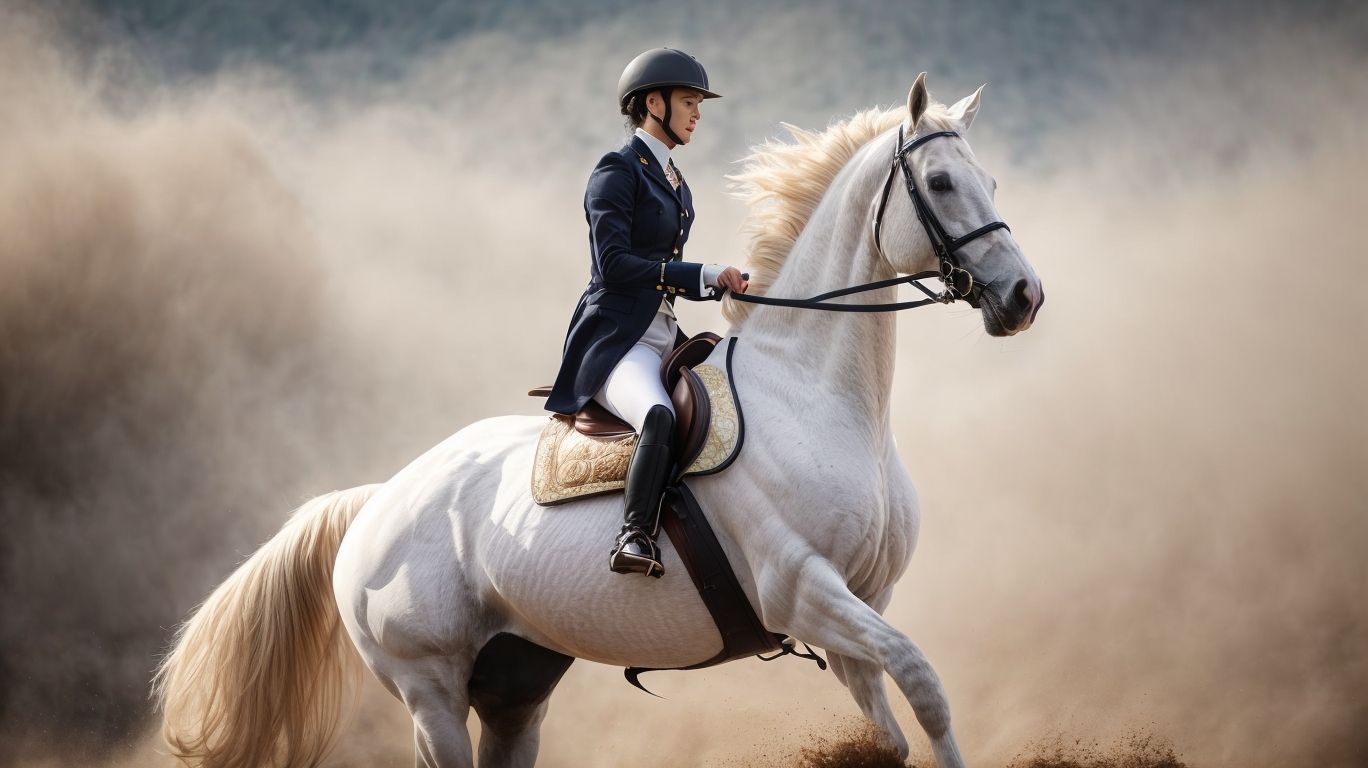Dressage, often referred to as the “highest expression of horse training,” is an equestrian discipline that showcases the harmony between horse and rider through precise and controlled movements. Mastering dressage riding techniques requires a strong foundation in basic skills and the ability to execute advanced maneuvers with finesse.
The basic dressage riding techniques serve as the building blocks for riders looking to excel in this discipline. These techniques include:
1. Position and Alignment: Achieving proper alignment and balance in the saddle is essential for effective communication with the horse.
2. Rein Aids: Understanding how to use the reins to communicate with the horse and achieve desired movements and responses.
3. Leg Aids: Proper use of leg aids to provide impulsion and direction to the horse.
4. Seat and Weight Aids: Utilizing shifts in weight and body position to communicate with the horse and maintain balance.
5. Transitions: Mastering smooth and precise transitions between gaits and movements.
Once riders have a solid understanding of the basics, they can progress to advanced dressage riding techniques. These techniques include:
1. Collection: Teaching the horse to shift their weight onto the hindquarters and engage their muscles for more advanced movements.
2. Extension: Developing the horse’s ability to lengthen their stride while maintaining balance and rhythm.
3. Lateral Movements: Executing movements such as shoulder-in, haunches-in, and leg yield to improve horse’s suppleness and flexibility.
4. Flying Changes: Achieving smooth and precise changes of lead during canter.
5. Pirouettes: Performing tight, controlled turns on the hindquarters.
To enhance dressage riding skills, riders can follow these tips:
1. Consistency and Practice: Regular practice is key to improving technique and developing a strong connection with the horse.
2. Developing Body Awareness: Increasing awareness of one’s body and its influence on the horse’s movements.
3. Working with a Trainer: Seeking guidance from a knowledgeable dressage trainer can provide valuable feedback and insights.
4. Fitness and Conditioning: Maintaining a fit and conditioned horse through proper exercise and conditioning programs.
While striving for excellence in dressage riding, it’s important to be aware of common mistakes that riders should avoid. These mistakes include incorrect positioning, inconsistent aids, lack of suppleness and flexibility, and overuse of aids.
By mastering both the fundamental and advanced dressage riding techniques, riders can elevate their skills, deepen their connection with their horse, and excel in the art of dressage.
Key takeaways:
- Proper position and alignment are essential in dressage riding. It helps maintain balance and aids in clear communication with your horse.
- Understanding rein aids and applying them correctly is crucial for effective communication and control while riding dressage.
- Awareness and correct application of leg aids are necessary to guide your horse’s movements and transitions during dressage riding.
Basic Dressage Riding Techniques
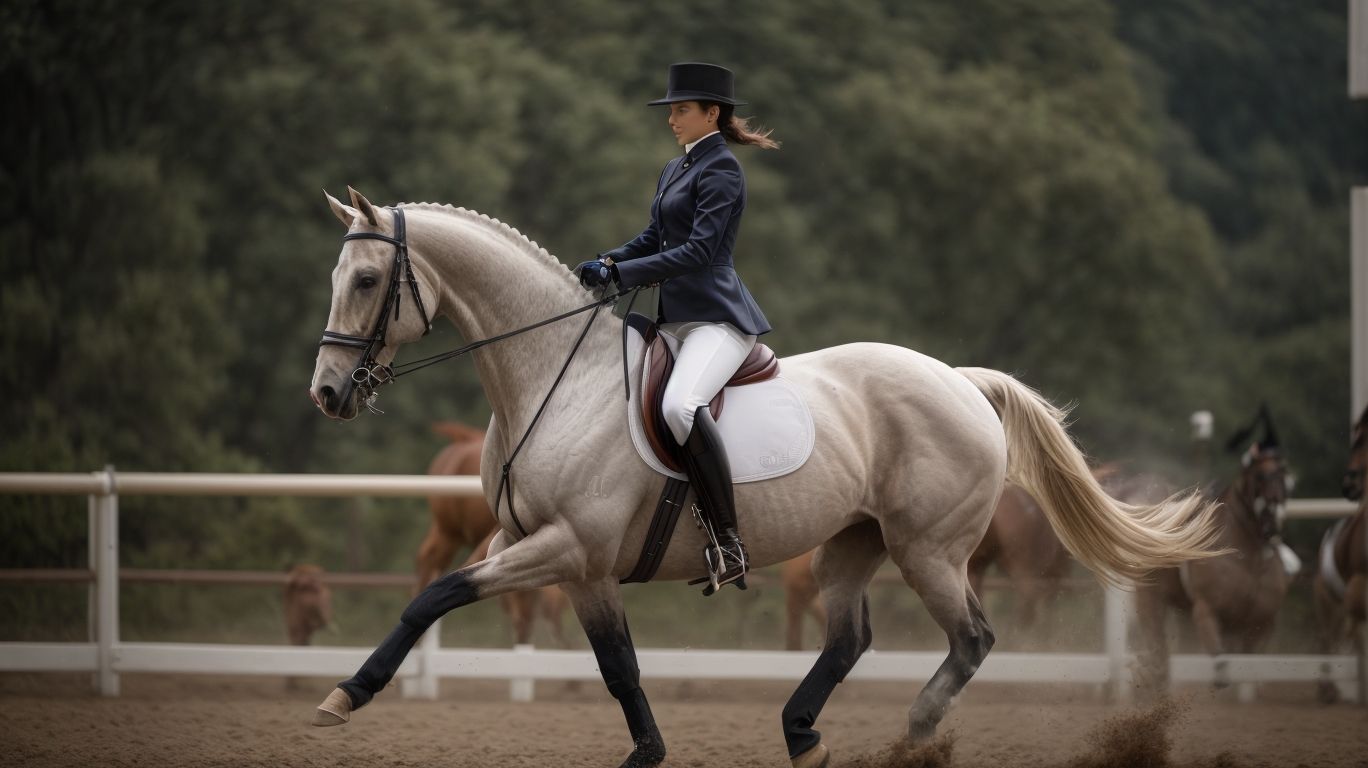
Photo Credits: Www.Horsespeakeducation.Com by Ralph Hill
Mastering the art of dressage riding begins with a solid foundation in basic techniques. In this section, we’ll uncover the key elements that make up these techniques, including position and alignment, rein aids, leg aids, seat and weight aids, and transitions. From maintaining proper posture to effectively communicating with your horse, we’ll explore how each component contributes to achieving grace and precision in the dressage arena. So saddle up and let’s dive into the fundamentals of dressage riding!
Position and Alignment
To achieve proper position and alignment in dressage riding, it is essential to follow these guidelines:
- Position: Ensure you sit tall with a straight back, relaxed shoulders, and heels dropped down. Remember to keep your head up and eyes forward to maintain a good position!
- Alignment: Make sure your ears, shoulders, and hips are aligned in a vertical line. It is also crucial to check that your elbows, wrists, and hands are in line with the horse’s mouth to achieve proper alignment.
- Engage your core muscles to maintain stability and balance while riding.
- By maintaining proper position and alignment, you enable effective communication with the horse through rein, leg, and weight aids.
Fact: Maintaining correct position and alignment not only enhances rider stability but also promotes the horse’s freedom of movement and optimal performance.
Rein Aids
Rein aids, also known as rein commands, play a crucial role in dressage riding, providing clear and effective communication between the rider and the horse. Mastering the use of rein aids is essential for achieving proper control and coordination with the horse. Here are some steps to effectively utilize rein aids:
- Direct rein: Apply consistent pressure on one rein to effectively turn or bend the horse in the desired direction. This helps in guiding the horse’s movements accurately.
- Indirect rein: Employ both reins together to communicate with the horse, maintaining a straight line or creating lateral movements. This allows for better coordination and communication between the rider and the horse.
- Half-halt: The half-halt technique involves a combination of gently pulling back on the reins while simultaneously using the seat and leg aids to balance and rebalance the horse. This helps in refining the horse’s movements and maintaining control.
- Release: It is crucial to loosen the reins occasionally to reward the horse for correct responses. This demonstrates trust and relaxation, encouraging the horse to continue performing well.
- Timing: Proper timing is of utmost importance in utilizing rein aids effectively. Timing the application and release of rein aids ensures clear communication with the horse, enhancing their understanding and responsiveness.
Remember, consistent practice, a deep understanding of the horse’s response, and working closely with a professional trainer can greatly enhance your mastery of rein aids. Keep on practicing and refining your skills to become a proficient rider.
Leg Aids
To properly execute leg aids in dressage riding, follow these steps:
1. Position: Maintain a correct and balanced position in the saddle, with your weight evenly distributed and heels down. Leg aids play a crucial role in maintaining this position and providing effective communication with your horse.
2. Leg position: Keep your legs relaxed and close to your horse’s sides, maintaining proper contact with your lower legs. This allows for clear and precise leg aids.
3. Leg aids for forward movement: Apply light pressure with your calves to ask your horse to move forward. Leg aids are instrumental in communicating your intention to your horse and encouraging them to respond appropriately. Increase the pressure if necessary to achieve the desired response.
4. Leg aids for lateral movement: To ask for lateral movement, use your inside leg slightly behind the girth while keeping your outside leg at the girth. Leg aids for lateral movement help in guiding your horse and maintaining their balance during movements such as leg-yields and shoulder-in.
5. Leg aids for collection: Apply gentle pressure with both legs to ask your horse to engage and collect their hindquarters. The correct application of leg aids enables your horse to develop the necessary strength and balance required for collection.
By correctly utilizing leg aids, you can effectively communicate with your horse and achieve precise movements in dressage riding. Leg aids are an essential component of dressage training, ensuring harmonious communication between horse and rider.
Seat and Weight Aids
Using correct seat and weight aids is essential in dressage riding for effective communication with the horse and achieving precise movements. Here are some key points to consider:
- Seat Alignment: Proper seat alignment is crucial. Sit straight, aligning your head, shoulders, hips, and heels.
- Weight Distribution: It is important to distribute your weight evenly in the saddle to maintain balance and stability. Avoid leaning forward or backward.
- Seat Influence: Utilize subtle weight shifts to communicate desired movements. For example, a slight shift of your weight to the inside can cue the horse for a turn.
- Balance and Stability: Developing a strong core is vital to maintain balance and stability in the saddle, enabling better communication with the horse.
- Pro-Tip: One useful tip is to practice riding without stirrups to improve your seat and balance. This will allow you to give clearer weight aids to your horse.
Transitions
Transitions are a crucial aspect of dressage riding, helping to achieve harmony and fluidity between movements. Here are some key points to consider:
- Clear and Smooth: Ensure transitions are clear and seamless, with precise timing and coordination between aids.
- Balance and Engagement: Transitions aid in developing the horse’s balance and engagement, improving overall performance.
- Variety: Practice a range of transitions, including walk-trot, trot-canter, and canter-walk, to enhance flexibility and responsiveness.
- Rhythm and Tempo: Maintain the consistent rhythm and tempo of the gaits during transitions for a harmonious flow.
- Half-Halts: Use half-halts, which are subtle transitions within a gait, to rebalance and prepare for upcoming movements.
Fact: Well-executed transitions not only showcase the horse’s training and obedience but also contribute to their physical and mental well-being.
Advanced Dressage Riding Techniques
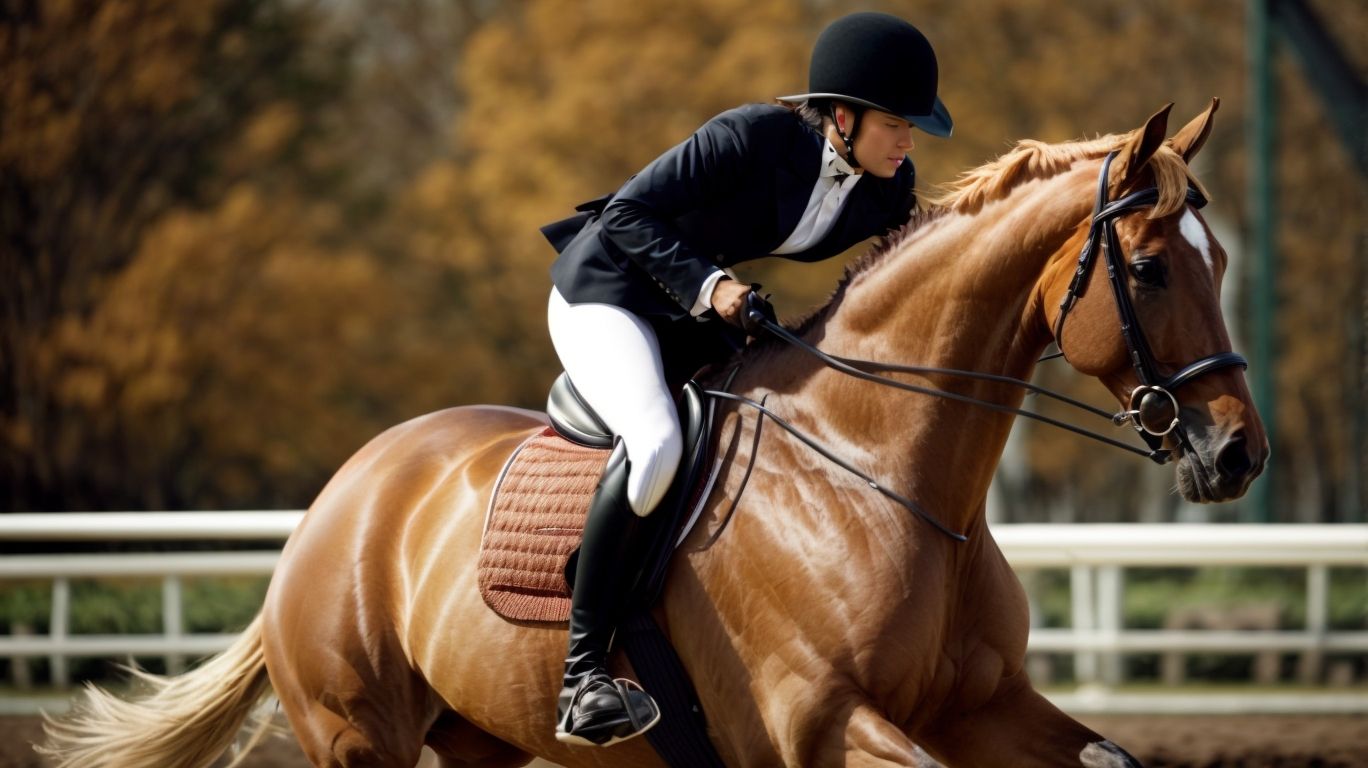
Photo Credits: Www.Horsespeakeducation.Com by Robert Lopez
Mastering the art of advanced dressage riding requires a deep understanding of various techniques that elevate your performance. In this section, we’ll explore the secrets behind collection, extension, lateral movements, flying changes, and pirouettes. These techniques push the boundaries of skill and precision, allowing riders to achieve unparalleled finesse and harmony with their horses. Get ready to delve into the intricacies of advanced dressage riding and unlock the potential for extraordinary equestrian excellence.
Collection
Collection is a crucial technique in dressage riding that requires a horse to gather its energy and engage its hindquarters. Achieving proper collection enhances balance, impulsion, and responsiveness to the rider’s aids. Here are key components of collection:
- Engaging the hind end: The horse needs to step further underneath its body with its hind legs, creating power and balance.
- Lifting the back: The horse should round its back, allowing the rider to have a soft and elastic connection.
- Increasing self-carriage: The horse should maintain its balance and carry itself without relying heavily on the rider’s aids.
- Flexibility and suppleness: The horse should be able to bend laterally and longitudinally, facilitating smooth transitions and movements.
- Developing impulsion: Collection increases the energy and “forwardness” of the horse, resulting in expressive movements.
Extension
Extension is a critical and advanced dressage riding technique that focuses on enhancing the horse’s stride length. It is a vital element in higher-level dressage tests, demanding strength, balance, and suppleness from both the rider and the horse. To successfully achieve extension, the rider must maintain a well-balanced and relaxed position, applying subtle aids through the seat, legs, and rein while encouraging the horse to move forward with impulsion and elasticity. Consistent practice, proper training, and guidance from a qualified dressage trainer play a crucial role in improving extension. Additionally, developing body awareness and fitness through targeted exercises can greatly aid in mastering this technique. It is important to progress gradually and prioritize the well-being of the horse throughout the training process to ensure success in extension.
Lateral Movements
- Lateral movements are advanced techniques in dressage riding that require precision and control from both the horse and rider. These movements involve the horse moving sideways while maintaining forward momentum. Here are some common lateral movements in dressage:
- Sideways: The horse moves sideways while remaining parallel to the track.
- Shoulder-in: The horse’s inside foreleg crosses in front of the outside leg, encouraging engagement and suppleness.
- Travers: The horse moves sideways with its hind legs following the track of its front legs.
- Half-pass: The horse moves diagonally across the arena with the shoulders leading and the hindquarters following.
During a dressage competition, a rider and her horse flawlessly executed a half-pass across the arena, impressing the judges with their harmony and precision. The lateral movements showcased their training and the horse’s natural talent for collection and engagement. Their successful performance earned them high scores and recognition from the audience. Lateral movements are not only technical but also demonstrate the partnership between horse and rider in the art of dressage.
Flying Changes
Flying changes in dressage riding, also known as flying changes, are a fundamental and advanced technique that involve changing leads in mid-air during the canter. Here are the steps for performing flying changes:
- Establish a balanced and collected canter on the correct lead.
- Prepare for the flying change by using half-halts and preparing your horse to shift its balance.
- Utilize your aiding system to cue the flying change, incorporating the rider’s seat, legs, and reins.
- Time your aids with the horse’s movement, asking for the flying change when the outside front leg is about to touch the ground.
- Shift your weight slightly to the new inside leg during the flying change to support the new lead.
- Reward your horse with praise and continue riding in the new lead.
Fun fact: Flying changes are a challenging movement in dressage, requiring precision, coordination, and training for both the horse and rider.
Pirouettes
Are a challenging yet elegant movement in dressage riding. Here are the steps to perform a successful pirouette:
-
Prepare your horse: Ensure your horse is supple, balanced, and responsive to your aids.
- Choose a small circle: Begin on a smaller circle, ensuring your horse stays collected and engaged.
- Engage the hindquarters: Use your seat and leg aids to engage your horse’s hindquarters and encourage the flexion of his inside hind leg.
- Create bend: Maintain a subtle inside bend while keeping your outside aids active.
- Control the tempo: Regulate the tempo with half-halts and ensure your horse is maintaining a balanced rhythm.
- Gradually decrease the circle size: As your horse becomes more collected, slowly decrease the size of the circle.
- Rotate around the inside hind leg: Use your seat and leg aids to initiate a rotation around your horse’s inside hind leg.
Pirouettes originated from the elaborate ballet movements of the seventeenth and eighteenth centuries and were incorporated into dressage to showcase the horse’s agility and balance. Today, pirouettes continue to captivate audiences with their grace and precision.
Tips for Improving Dressage Riding Skills
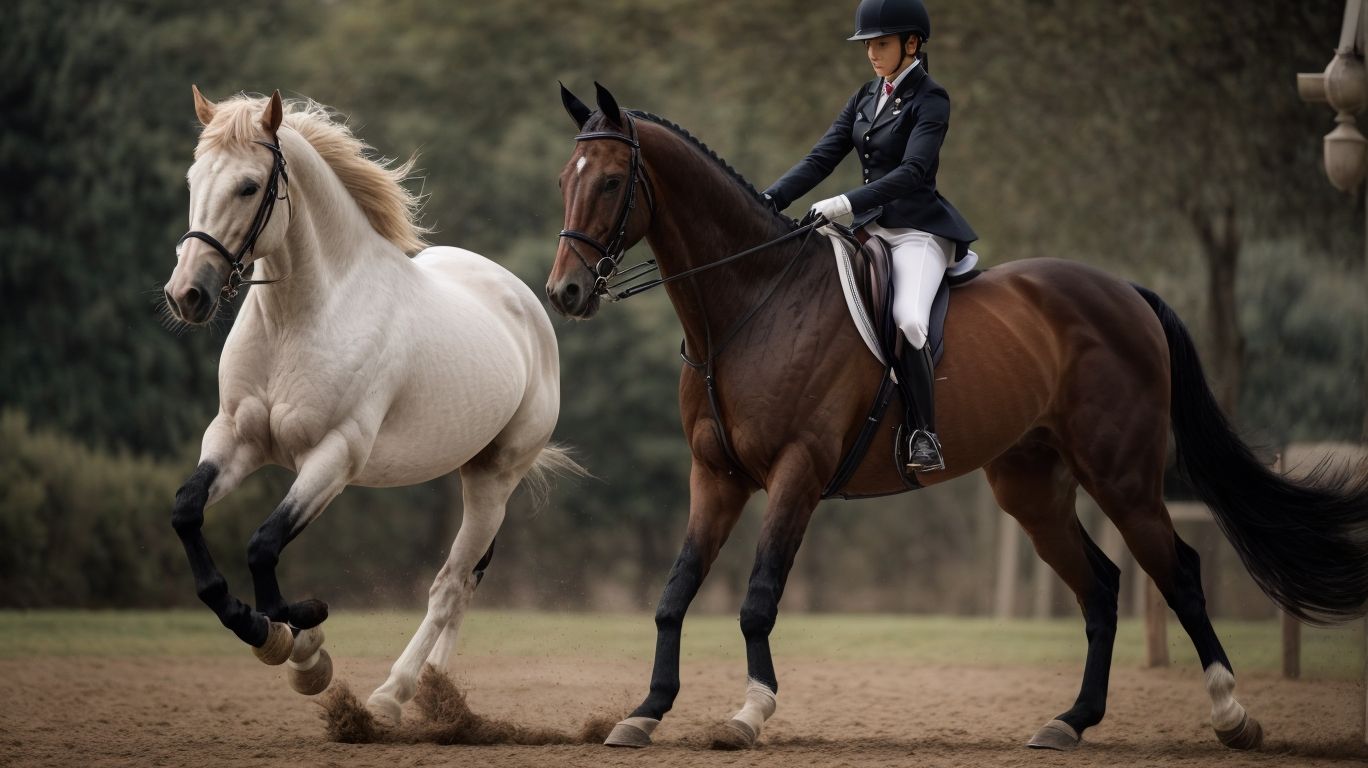
Photo Credits: Www.Horsespeakeducation.Com by Kyle Mitchell
Looking to up your dressage riding game? This section is all about enhancing your dressage riding skills. Get ready for some insider tips that will take your performance to the next level. We’ll be diving into the importance of consistency and practice, developing body awareness, working with a trainer, and how fitness and conditioning can elevate your dressage techniques. So, saddle up and let’s improve those dressage riding skills!
Consistency and Practice
Consistency and practice are essential for improving dressage riding skills. To enhance your abilities in dressage, it is crucial to incorporate the following tactics:
1. Establish a regular riding schedule to maintain consistency in your training routine.
2. During each practice session, focus on specific techniques and exercises.
3. Break down complex movements into smaller components and practice them individually for better mastery.
4. Strengthen muscle memory by incorporating mental imagery and visualization techniques.
5. Seek feedback from experienced trainers or professionals to identify areas for improvement.
By dedicating yourself to consistent practice, you can refine your skills and achieve greater mastery in dressage riding.
Fact: Did you know that Charlotte Dujardin and her horse Valegro hold the world record for the highest dressage score? They achieved a remarkable score of 93.4%!
Developing Body Awareness
Developing body awareness is crucial in dressage riding as it allows riders to have better control and coordination with their horses. Here are some steps to enhance the development of body awareness:
- Prioritize posture: Give utmost importance to maintaining correct alignment of the spine, shoulders, and hips, aiming to improve body awareness and stability.
- Engage in body scanning: Make it a regular practice to check in with your body, identifying and releasing any tension or tightness that may hinder body awareness.
- Integrate stretching and flexibility exercises: By incorporating exercises that promote flexibility, you will gain a deeper understanding of your body’s movements and be able to respond accordingly.
- Harness visualization techniques: Utilize the power of visualization to imagine and visualize your body’s position and movements during various dressage exercises. This will greatly enhance the mind-body connection.
- Cultivate mindfulness through breath: Allow yourself to take mindful breaths, as deep breathing can center you and heighten your awareness of your body’s sensations and movements.
By integrating these steps into your dressage training, you can enrich your body awareness and elevate your overall riding performance.
Working with a Trainer
Working with a trainer is essential for enhancing dressage riding skills. Trainers offer valuable guidance, feedback, and support to assist riders in reaching their full potential. Here are several steps to consider when collaborating with a trainer:
1. Evaluate your objectives: Have a discussion with your trainer about your riding goals and aspirations to establish a clear direction for your training.
2. Formulate a training plan: Work together with your trainer to create a personalized training plan that focuses on your particular strengths and weaknesses.
3. Attend regular lessons: Make it a point to participate in regular lessons with your trainer to receive personalized instruction and feedback on your riding technique.
4. Practice outside of lessons: Apply the exercises and techniques discussed during your individual practice sessions.
5. Set achievable milestones: Collaborate with your trainer to set realistic milestones to track your progress and maintain motivation throughout your training journey.
6. Maintain open communication: Foster honest and open communication with your trainer to address any concerns or questions you may have.
7. Continuously learn: Take part in clinics, workshops, and seminars alongside your trainer to expand your knowledge and skills.
Remember, working with a trainer is an ongoing process that necessitates commitment, dedication, and a willingness to learn and improve.
Fitness and Conditioning
Achieving success in dressage riding requires good fitness and conditioning. Here are some tips to naturally improve your fitness and conditioning for dressage riding:
- Regular exercise: Engage in cardiovascular activities, such as running or cycling, to naturally improve your endurance and stamina.
- Strength training: Focus on exercises that naturally target your core muscles, including planks and Pilates, to improve stability and balance.
- Flexibility training: Incorporate stretching exercises, such as yoga or dynamic stretching, to naturally enhance your range of motion and suppleness.
- Avoid overtraining: Allow for rest days and listen to your body to naturally prevent injuries and burnout.
- Mental fitness: Practice mindfulness and visualization techniques to naturally improve focus and concentration during rides.
Remember, a well-conditioned body will naturally enhance your performance and help you excel in dressage riding. Keep up with your fitness routine and stay committed to your goals. Happy riding!
Common Mistakes in Dressage Riding
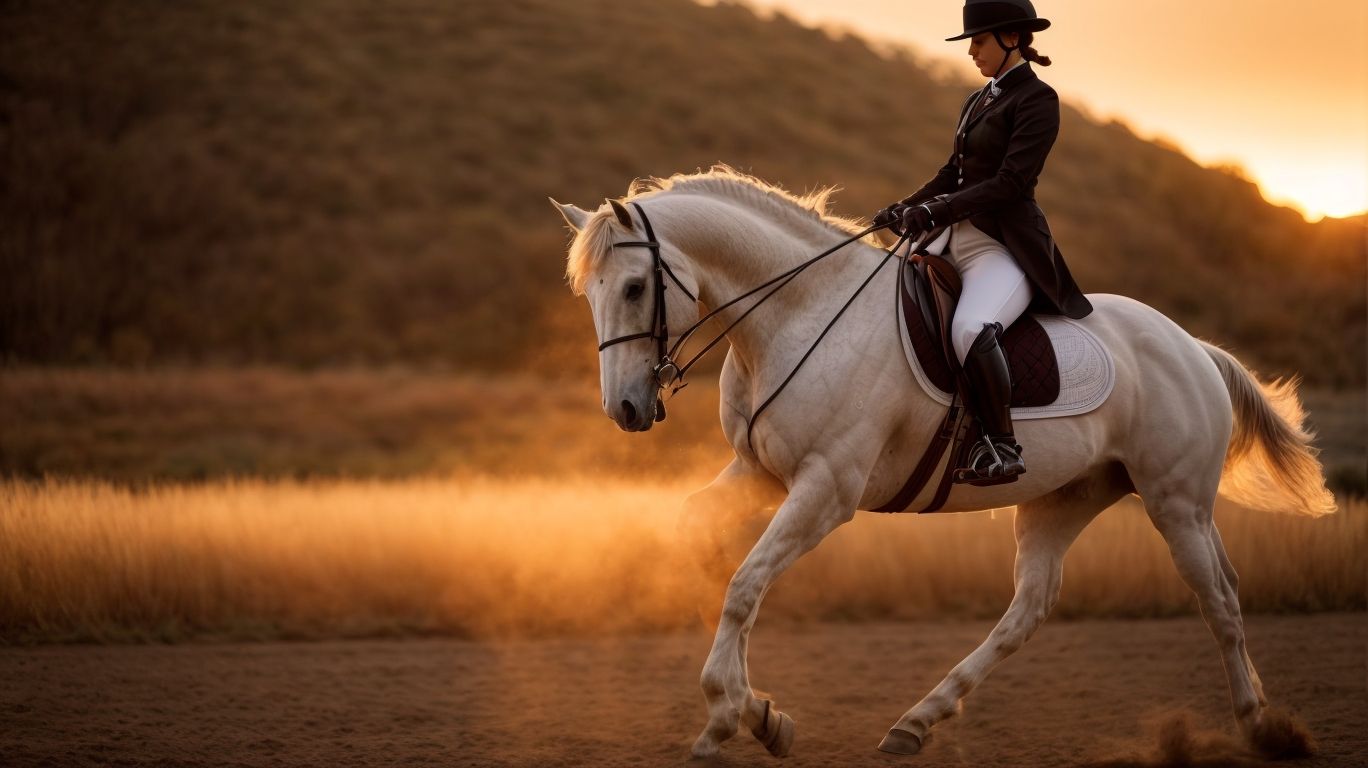
Photo Credits: Www.Horsespeakeducation.Com by Donald Martin
Don’t let these common mistakes hold you back in the world of dressage riding! In this section, we’ll uncover the key blunders that riders often make, inhibiting their progress and harmony with the horse. From improper positioning to inconsistent aids, lacking suppleness and flexibility to overusing aids, we’ll dive into the nuances of each sub-section. Get ready to enhance your skills and take your dressage riding to the next level!
Incorrect Positioning
Incorrect positioning is a remarkably common mistake in dressage riding that can significantly hinder the rider’s overall performance. It has the potential to cause an imbalanced seat, make it challenging to give proper aids, and ultimately result in a decreased connection with the horse. To steer clear of this erroneous positioning, riders should prioritize maintaining a straight line extending from their shoulder to their hip, ensuring that their ear, shoulder, hip, and heel are perfectly aligned. Additionally, the rider’s hands should remain steady and in perfect harmony with the horse’s mouth. Consistent practice, heightened body awareness, and collaborating closely with a knowledgeable trainer can effectively assist riders in enhancing both their positioning and their overall dressage riding abilities.
Inconsistent Aids
Inconsistent aids can lead to confusion and hinder progress in dressage riding. To address this issue, riders must strive for consistency in their instructions to the horse. Here are some common mistakes to avoid:
| Mistake | Consequence |
| Inconsistent use of rein aids | Confuses the horse and results in inconsistent responses |
| Irregular leg aids | Creates uncertainty and can disrupt the horse’s balance |
| Lack of seat and weight consistency | Leads to mixed signals and difficulty in maintaining harmony with the horse |
| Varying application of aids during transitions | Causes the horse to anticipate or become unresponsive |
Consistency in aids is vital for effective communication between rider and horse, allowing for harmonious movement and progression in dressage. Remember, clear and consistent aids lead to better results and a more harmonious partnership with your horse.
Lack of Suppleness and Flexibility
Lack of suppleness and flexibility is a frequent mistake in dressage riding. It can impede the horse’s movement and overall performance. To tackle this issue, riders should prioritize exercises that promote suppleness and flexibility, such as stretching exercises and lateral movements. Working on transitions and utilizing correct aids can also enhance suppleness. Consistent training and regular practice play a crucial role in developing the horse’s flexibility. Additionally, incorporating exercises like shoulder-in and leg-yield can further augment the horse’s suppleness and flexibility. It is a fact that proper warm-up and cool-down routines are vital for maintaining the horse’s suppleness and preventing injuries.
Overuse of Aids
Overutilization of aids in dressage riding has the potential to impede the harmony and finesse between the rider and the horse. It is crucial to remain aware of the level and timing of aids to prevent any confusion and unnecessary pressure on the horse. Here are some suggestions to prevent excessive use of aids:
– Hone your aids: Establish a subtle system of communication with your horse by utilizing minimal aids that are both clear and precise.
– Timing is paramount: Employ aids at the appropriate moment to avoid unnecessary pressure or confusion. Anticipate and provide aids only when necessary.
– Depend on body language: Enhance your body language and weight shifting to effectively communicate with your horse, thereby reducing reliance on rein and leg aids.
– Regular training: Consistency and practice will assist in developing a better understanding of your horse’s response to aids, enabling you to use them more efficiently.
Some Facts About Dressage Riding Techniques:
- ✅ Dressage work benefits horses by making them stronger, more balanced, supple, and comfortable to ride. (Source: Our Team)
- ✅ Accuracy is crucial in dressage, and practicing it helps improve control and responsiveness in horses. (Source: Our Team)
- ✅ Exercises aimed at improving accuracy in dressage include performing transitions precisely at a marker and counting strides for smooth transitions. (Source: Our Team)
- ✅ Staying straight is vital for a horse’s alignment and flexibility. Riders should sit evenly and balanced in the saddle and identify their horse’s stiff side. (Source: Our Team)
- ✅ Straightness is a constant battle that requires constant awareness in dressage riding techniques. (Source: Our Team)
Frequently Asked Questions
What are the benefits of dressage work?
Dressage work is beneficial for all horses as it makes them stronger, more balanced, supple, and comfortable to ride.
How can accuracy be improved in dressage riding?
Practicing accuracy in dressage improves control and responsiveness in horses. Exercises such as doing transitions exactly at a marker and counting strides for smooth transitions can help improve accuracy.
What should riders focus on to ensure their horse stays straight?
To ensure a horse stays straight, riders should sit evenly and balanced in the saddle and identify their horse’s stiff side. Common issues when a horse is not straight include counter-bending and stronger contact on one rein.
What does Carl Hester emphasize regarding downward transitions?
Carl Hester emphasizes the importance of downward transitions in building strength and balance in young horses. Rushing these transitions can lead to the horse breaking down in tests.
What does Isabell Werth recommend for developing a better connection with the contact?
Isabell Werth recommends working in the walk, specifically a session of collect and let go, to develop a better connection with the contact. She believes that working in the walk can address many training issues.
What exercise does Robert Dover suggest to improve throughness and straightness?
Robert Dover suggests the rubber-band exercise to improve throughness and straightness. This exercise involves moving the horse from collected trot to medium trot and back.
